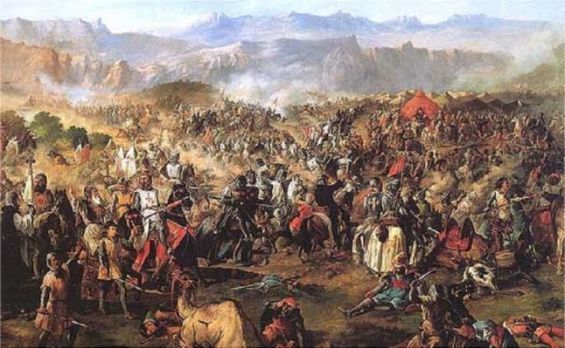The Fatimid Caliphate, known in history as an Ismaili Shia Islamic state, has controlled between the 10th and the 12th century a large territory spreading from North Africa to the Red Sea. Ruling across the Mediterranean Sea, the dynasty of Arab origin has influenced the way Moroccans perceived Islam, practiced it and understood it. The Shia dynasty has implemented their doctrine in Morocco relying on Berbers who helped the Fatimid grow on the military and political levels.
However, the Fatimid Caliphate quickly shrinked and returned to Egypt in 972 after being kicked out by the Almoravids who ruled Morocco from 1040 to 1147. Although they left Morocco for Egypt, the Fatimid’s influence left its marks on the area. Established in Kutama in the North of present-day Algeria, the Caliphate formed the Fatimid army which eventually overthrew the Aghlabids who controlled Ifriqiya (Tunisia), and then went on to conquer Egypt and the southern Levant in 969–975. Later on, Kutama remained one of the mainstays of the Fatimid army until well into the 11th century.
 The architecture of the Fatimids./Ph. DR
The architecture of the Fatimids./Ph. DR
Cadi Ayyad, one of the famous scholars of Maliki law and author of the well-known Ash-Shifa, who was the great Imam of Ceuta and high judge in Granada during the Almoravid dynasty, described in his book «Tartib al-mardarik wa-taqrib al-masalik li-marifat alam madhab Malik», a collection of biographies of eminent Malikis, the situation in North Africa at the time. «The Sunnis in Kairouan (a city in Tunisia) when the sons of Ubayd Allah al-Mahdi Billah (founder of the Fatimid dynasty) ruled the city, were secretive, cautious as if they were non-Muslim citizens and they were suffering a lot. But when Ubayd Allah knew what they were hiding he ordered his followers to take the streets and insult the prophet», wrote the distinguished judge.
Faced with the delicate situation, Hassan bin Ali bin Rashid Al-Bajali, a scholar who was appointed by the Fatimids in Tunisia to spread the Shia doctrine, decided to pack and leave for Morocco, most precisely the Souss region, around the third century of the Hijri calendar (9th century AD). For him, mid-southern Morocco was the perfect place to start over and preach the Ismaili doctrine.
Traveling to the Souss region
Commenting on this historical era, Abdel Majid Al-Najjar wrote in his book «Al-Mahdi Ibn Tumart : His Life, Views, Intellectual and Social Revolution and the impact he had on Morocco» that the tribes in the Souss region were very strong and fierce. In his account, Al Najjar explains how these tribes used to see the world around them, interpreting everything in a spiritual way. «They were known for practicing astrology, and wizardry and their ability to find buried treasures», indicated the same author.
According to Al-Najjar, the inhabitants of the region were simple, shallow and did not bother having a deep understanding of religion which made it very easy for Hassan bin Ali bin Al-Bajali. The latter seized the opportunity, in other words, to spread the doctrine he was following.
Ibn Al-Bajali was able to gain followers in the Souss region. That was confirmed by Ibn Hazm, an Andalusian poet, historian and jurist who was a leading proponent of the Zahiri school of Islamic thought, in his famous book «Al-Fisal fi al-Milal wa al-Nihal» (The Separation between Religions, Heresies, and Sects). Referring to Al-Bajali, Ibn Hazm wrote that : «This infidel traveled to Souss, located in the farthest region of the Masmuda tribes, misleading their Berber prince Ahmed bin Idriss bin Yahya bin Abdullah bin Hussein bin Hassan Ali bin Abi Talib». According to his version of the story, the historian stressed that the tribes have been following a new doctrine claiming that God chose Ali to be Prophet Muhammad's successor.
Two clans praying in one mosque
Abdelmajid Al-Najjar described the situation in Souss after the spread of the Shia Islam saying that the region witnessed a doctrinal war, where the Shia clashed with Sunni followers.
«The Shia presence in the region lasted for two centuries and their relations with the Sunnis and Malikis was conflictual. It was marked by rejection and tension».
He added that there were two groups in the region, a clan controlled by Al-Bajali and the other was ruled by the Malikis. The two groups, according to the same book, were praying in the same mosque but in different parts of the day.

Interviewed by the Moroccan daily newspaper, Al Ittihad Al ichtiraki, Mohammed al-Maghraoui, a professor at the University of Mohammed VI in Rabat, said that : «The Iraqi traveler Ibn Hawqal, who visited Morocco in 350 (Hijri calendar), recalls that the prayer was held twice in the Taroudant mosque. The Malikis used to pray first and leave a room for the Shia insisting that the two groups used to often clash».
Kicked out by the Almoravids
Nearly two centuries after the start of the presence of the Shia doctrine in Morocco, most precisely in the Souss region, a Sunni group was on the rise laying the foundation stone for the Almoravids' dynasty. The latter came to put an end to the Shia doctrine in the North African country.
Abdallah ibn Yassin, the founder of the Almoravid dynasty imposed a strict discipline forming a strong army which he ordered to reunite the country and put an end to doctrinal wars.
Abū al-Hassan ‘Alī ibn Abī Zar‘ al-Fāsī said in his book «Rawd al-Qirtas», an influential medieval history of Morocco said to have been written at the instigation of Marinid Sultan Abu Sa'id Uthman II, that «when Yahya ibn Omar (the Almoravids' first military leader) died, Abdallah bin Yassin ordered his brother Abu Bakr ibn Omar and his command of war to invade the Souss region in Rabii-II 448 (Hijri calendar) and retake Sijilmassa and the surrounding lands».
 Almoravids army./Ph. DR
Almoravids army./Ph. DR
Led by Abdallah ibn Yassin, the Almoravids managed to seize back the region of Souss and restrain order by spreading the Sunni doctrine once again.
Although the Almoravids managed to clear out the existence of Shia in Morocco, the leftovers of this doctrine were embodied in the cultural imagination of Berbers and Moroccans in general. Many traditions, rituals and beliefs have survived making it to our modern day culture.
The most significant element that makes us think of the Shia existence in Morocco is the celebration of Ashura, a commemoration that still bears some elements of this forgotten doctrine.





 chargement...
chargement...













